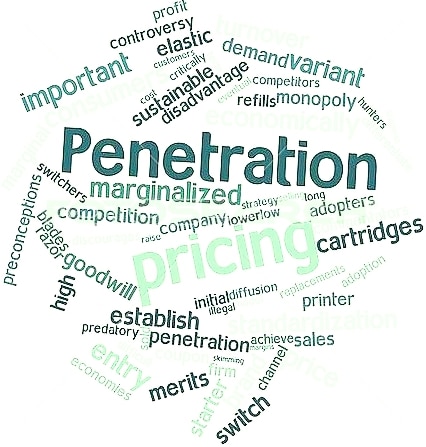As a company owner, you’ll have to make important choices about how to sell your product or service to new customers. A penetration pricing strategy, which is often used for new goods, allows you to gain customers quickly. Also, one can apply this penetration pricing strategy when entering new markets. Let’s see how penetration pricing works with some real-life examples.
What is Penetration Pricing?
Penetration pricing is a marketing technique used by businesses to draw consumers to a new product or service by selling it at a cheaper price after the initial launch. A lower price assists a new product or service in entering the market and luring consumers away from rivals. Market penetration pricing is based on the practice of initially charging low rates to make a large number of consumers aware of a new product.
A price penetration strategy’s aim is to entice consumers to try a new product and gain market share, with the intention of retaining the new customers once prices return to normal levels. Examples of penetration pricing include an online news website providing one month of free service for a subscription-based service or a bank providing a free checking account for six months.
Price Skimming vs Price Penetration
They often confuse price skimming with penetration pricing, but the two techniques are somewhat different.
A marketing penetration strategy is when a company foregoes margins to attract customers to its products. They often use it when a new business or product enters a market, and the primary target is to gain as many users as possible. Penetration pricing is less flexible than price skimming due to the razor-thin margins.
On the other hand, price skimming is a margin-maximizing technique that companies use for luxury goods or other high-ticket products in inelastic categories. Instead of charging a low price for a commodity, businesses that use a price skimming strategy can charge a high price and optimize for high margins.
Businesses that often employ price skimming are those with strong brand awareness and loyalty, or by brands that provide substantial distinction from rivals. As a result, companies like Apple will charge extremely high prices for new and creative goods.
5 Examples of the Best Penetration Pricing Strategies
Here are five real-world examples of penetration pricing strategy in action. If you use one of these penetration pricing techniques, you will be investing in long-term gains even if you make a loss in the short term.
#1. Netflix
Netflix is the epitome of proper penetration pricing. People often complain about the increase in Netflix subscription rates or the expiration of their one-month free trial period. Nonetheless, despite occasional grumbling, people are perfectly happy to pay higher subscription fees in exchange for an endless stream of good media content. Today, Netflix is the industry leader, accounting for 51% of online subscriptions in the United States. Other OTT platforms are following suit, implementing penetration pricing in order to draw new customers.
#2. Internet Service Providers
Television and Internet service providers are infamous for using penetration pricing, much to the chagrin of customers who see large and unexpected rises in their bills. Comcast/Xfinity, for example, often offers low introductory rates, such as free or heavily discounted premium channels, and low incremental upgrade costs. We estimate that the company has raised its Internet access market share in the areas it serves from around 56 percent to 64 percent over the last five years, with almost all of the share coming from phone companies.
Although that share change can seem minor, it means that Comcast’s customer base in a given region is now more than 60% greater on average than that of its competitors, up from about 20%. The price rises at the end of a given duration. Most customers continue to pay the higher bill, but some switch to a new company that offers an introductory rate.
Other service companies depend on penetration pricing as well. In a market increasingly dominated by smartphones, landline providers may use penetration pricing to entice customers to buy a landline. Some also combine these offers with cable, internet, and smartphone bundles.
#3. Providers of Smartphones
Consider two big mobile operating systems with radically different pricing strategies.
Through a penetration scheme, Android strives for greater consumer penetration. Android phones, with Samsung leading the pack, are available at steep discounts or significantly lower prices than Apple. They hope that consumers will become brand loyal. This approach also allows a broader variety of customers to access the Android marketplace. Apple pursues a skimming strategy, offering high-priced goods that take a limited market share off the top.
Penetration pricing is also common among smartphone providers. In this program, operators sell low-cost or free mobile phones in exchange for long-term customer contracts. Consumers are enthralled by low-cost phones. They, however, fail to note that the contracts cost much more in the long run than the phone itself.
#4. Gillette
Gillette is one company that comes to mind when discussing a good penetration pricing strategy. With its razors often given away for free or at a cheaper price than rivals, it has been able to maintain its market leadership position for several years. Gillette makes up for lost sales by selling razors at low prices and high-priced razor blades, extensions, and accessories. When you are new to the market and gaining brand awareness, offering disruptive prices is an effective way to distinguish your brand from rivals who are all selling similar products in the fast-moving consumer goods (FMCG) space.
#5. Food and Drinks
Food companies use the penetration pricing technique to bring many new foods to the market. Some companies also give away packages of new items by sponsoring events and delivering sample packs to attendees. When you walk into a store, you can often see ads for introductory low rates on certain fresh products. These are great examples of penetration pricing. Costco and Kroger use penetration pricing for organic goods to boost demand for these items. These grocery stores profit from increased demand and high sales rates. This is because organic goods have a higher margin and because of economies of scale.
Another notable example is Starbucks, a luxury coffee chain. They often launch fresh and seasonal coffees and beverages at a lower price point to entice customers to try these new products. As customers become accustomed to these items on the menu and react positively, Starbucks withdraws the penetration pricing deals. They resume selling them at their regular, non-discounted rates.
Aside from these main examples, we see penetration pricing techniques used in a variety of sectors. The sectors include hotels, airlines, and consumer goods. Using this pricing strategy strategically can be a sure way to build a loyal customer base. Hence, you gain a foothold in a highly competitive market.
The Benefits of Penetration Pricing
- Adoption and diffusion are extremely high: Penetration pricing allows a company’s product or service to be embraced and adopted by consumers easily.
- Market dominance: Competitors are often caught off guard by a penetration pricing strategy and have little time to react. The organization should take advantage of the ability to convert as many clients as possible.
- Economies of scale: The pricing strategy produces a large number of profits, allowing a company to understand economies of scale and lower its marginal cost.
- Increased goodwill: Customers who find a good deal on a product or service is more likely to return to the company in the future. Furthermore, increased goodwill generates positive word of mouth.
- High inventory turnover: Penetration pricing increases inventory turnover, which pleases vertical supply chain partners such as retailers and distributors.
The Drawbacks of Penetration Pricing
- Expected pricing: Customers frequently demand perpetually low rates when a company employs a penetration pricing strategy. Customers may become unhappy and stop buying the product or service if prices gradually rise.
- Low customer loyalty: Bargain seekers or those with low customer loyalty are usually drawn to penetration pricing. If they find a better offer, consumers are likely to turn to rivals. Price cuts, while useful for short-term sales, seldom result in consumer loyalty.
- Low prices can harm brand reputation by leading consumers to view the brand as cheap or of poor quality.
- Price war: A price war can be triggered by a price penetration strategy. This reduces overall market profitability. Only businesses large enough to survive a prolonged price war are typically not the new entrant that started it.
- Long-term strategy inefficient: Price penetration is not a feasible long-term pricing strategy. It is normally a smart choice to enter the market with a pricing plan that your business can live in the long run. Although it can take longer to gain a significant market share, such a patient, long-term approach is more likely to benefit the business in the long run and expose you to less financial risks.
When can a penetration pricing approach be used?
When the product is highly elastic and there is little difference between Product A and Product B, a penetration pricing strategy is more likely to be successful. If customers are both price-sensitive and similar goods are nearly identical to yours, it’s a great breeding ground for the price to be the only differentiator.
Why is this so? since, according to basic economic theory, lowering the price would increase demand. And if your product promises greater value for money, customers will easily choose it over a competitor.
Assume you’re in the business of selling blenders. Both blenders have the same basic function: they mix liquids. Shaper blades may be present in others. Some may be of higher quality. However, for many customers, these features are insignificant. They want something that will last a long time and blend up smoothies every morning—nothing more, nothing less.
A market penetration pricing strategy might be a perfect way to get your brand recognized if you wanted to bring a new blender to the market. If you can create a thoughtful marketing plan around your pricing strategy, you can maintain that focus while still building brand awareness and perception. If you are good, potential customers will not be bothered by higher prices because they will recognize the importance of the product.
How can businesses determine the optimal price for penetration pricing?
The optimal price for penetration Pricing can be determined through market research, competition analysis, and consideration of cost structure.
What are the disadvantages of penetration pricing for businesses?
The disadvantages of penetration pricing for businesses can include lower profit margins initially, difficulty in raising prices later, and potential harm to brand reputation.
How can businesses implement penetration pricing effectively?
Effective implementation of penetration pricing requires careful planning, market research, and a clear understanding of target customers and competition.
How does penetration pricing work in the online marketplace?
Penetration pricing can be used in the online marketplace by offering lower prices initially to attract customers and gain market share.
What are some best practices for businesses using penetration pricing?
Best practices for businesses using penetration pricing include thorough market research, monitoring competitors, regularly evaluating the effectiveness of the pricing strategy, and adjusting the strategy as needed.
How does penetration pricing impact pricing power in a market?
Penetration Pricing can impact pricing power in a market by establishing a low initial price and potentially creating barriers to entry for new competitors. However, it can also limit a business’s ability to raise prices later on.
Final thoughts
Penetration pricing is an excellent strategy for entering a new market and getting the product noticed. However, be cautious in your execution. If done incorrectly, penetration pricing will hurt rather than improve the brand’s reputation, and no one wants that.
Penetration Pricing FAQs
What is an example of price penetration?
Netflix is the perfect example of penetration pricing done right. We have often heard people complain about their Netflix subscription prices going up or their one-month free subscription expiring. … Other OTT platforms are following suit by deploying penetration pricing to attract new customers.
Who uses penetration pricing?
13 penetration pricing examples
- Streaming companies. …
- Internet and cable providers. …
- Banking institutions. …
- Hospitality services. …
- Grocery stores. …
- Airline companies. …
- Online education programs. …
- Product manufacturers.
When should penetration pricing be used?
Penetration pricing is often used to support the launch of a new product and works best when a product enters a market with relatively little product differentiation and where demand is price elastic – so a lower price than rival products is a competitive weapon.
How does penetration pricing discourage rival companies from entering the market?
How does penetration pricing discourage rival companies from entering the market? … The first company would have a higher volume and lower unit cost, while the competitor would experience the opposite. 2. Usually, none of the companies would make much profit in this situation.






